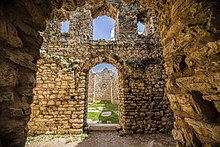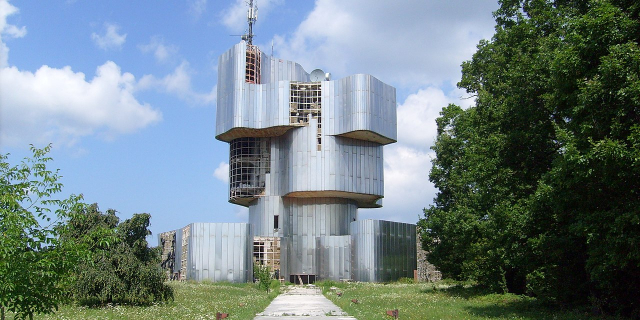The Church of the Holy Salvation or Holy Saviour (Croatian: Crkva Sv. Spasa) was a Pre-Romanesque church in the Dalmatian Hinterland, Croatia, whose ruins are now a historic site. It is located in the small village of Cetina, near the spring of the river Cetina, 8 km northwest from the town of Vrlika.
The remains of the church are of historical significance in Croatia, as it is the only pre-schism church constructed with a bell tower which is still standing.
The church was built near Vrlika, called Vrh Rike in the 9th to 10th century.[1] It was dated to the time of Duke Branimir of Dalmatian Croatia through comparative analysis of an altar beam with other artefacts carrying Branimir's name by Ivo Petricioli in 1980 and 1984.[2] It is one of the oldest and best preserved larger monuments of the early pre-Romanesque sacral architecture.[3]
It was commissioned as a private church by the local župan (district-prefect) Gastika of Cetina, at the recommendation of Pope Stephen VI, in memory of his family.[4] This is confirmed by inscriptions from a beam taken from the altar, which notes in Latin: AD ONOREM D(omi)N(u)M N(ostri) IESU CHR(ist)I EGO GASTICA HUPPANUS D(onavi) [...] I ET ANIMATE MEE ET MATR(i)S MEE NOMINE NEMIRA ET F(i)LIIS MEIS NOMINE.[5] It translates that the church had been dedicated to Christ and built on the order of the prefect Gastika, the son of Nemira.[6] The beams are held along with other artifacts found at the site at the Archaeological Museum in Split.
DestructionIn the early 15th century, Hrvoje Vukčić strengthened the Prozor Fortress, and most of the inhabitants moved out of Vrh Rika into Vrlika.[citation needed] After a 1492 invasion by the Ottoman Empire, the church and the settlement sustained heavy damage and a substantial part of the inhabitants fled to Turopolje.[1] The church subsequently fell to ruin. The ruins of the church and surrounding tombs were described by the Archbishop of Split Stjepan Cupilli during his tour of his archdiocese lands in 1708, as well as Alberto Fortis during his travels in 1774, and Ivan Lovrić in 1776.[7]
Despite its damaged state, the church ruins were still viewed as a sacred site by the local population. Franciscan archaeologist Stjepan Zlatović described the pilgrimage local Catholics continued to make every year on Ascension Day, where the Vrlika parish priest would hold a special mass within the church ruins.[8]
In the late 19th century, Franciscan friar Lujo Marun of the Knin parish became the first person to conduct an excavation of the site, the findings which he published in 1895 and 1896.[9] Marun took the first known photograph of the church in 1894, which turned out to be immensely valuable for future researchers, as the photograph depicts parts of the church wall which no longer exist.[10] Despite his efforts, Marun was unable to complete his work and could not therefore offer conclusive evidence on the church's formation.[10]
Modern Inside the church
Inside the churchIt wasn't until 1947 that a more scientific, archaeological excavation of the site was conducted by the Museum of Croatian Archaeological Monuments.[11] Led by renowned archaeologist Stjepan Gunjača, the team's work focused on excavating inside the church along with the surrounding area and preserving what was left of the existing structures.[12] It was Gunjača and his team who discovered the altar beam confirming district prefect Gastika as the donor for the church.[13] The team unearthed hundreds of old-Croatian graves, many containing jewelry, coins, belts, weaponry, and other artifacts now kept at the archaeology museum in Split.[13][14] With these findings, the Croatian archaeological group was able to put the age of the church at the late 9th century.[15]
The Serbian Orthodox Eparchy of Dalmatia published a conflicting assessment of the origin of the Holy Salvation,[16] originally published by Mirko Ležaić in 1939 in Belgrade, saying Tvrtko I built it, and that it was destroyed by the Turks in 1512.[17] This is refuted by the archaeological and historical evidence which conclusively dates the foundation of the church and surrounding graves to the 10th century at the latest.[18][19][20]
The historical and spiritual ownership of remains of the church has long been a source of tension between the local Croatian Catholic and Serb Orthodox population, with both sides claiming ownership. After the archaeological excavations were completed in 1954, the Serbian Orthodox population began a campaign of burying their dead haphazardly throughout grounds in order to lay claim to the church.[21] In 1983 monks from the Serbian Orthodox Church erected iron barred gates at the entrance of the church and walled off the windows to keep to prevent Catholics from utilizing the church.[22][23][24] At the same time an ancient wall fragment depicting the Croatian interlace was also destroyed.[23] It was not until after the end of the war that Catholics were able to return to the church and continue their yearly pilgrimage to celebrate the Ascension.[25][26]

































Add new comment